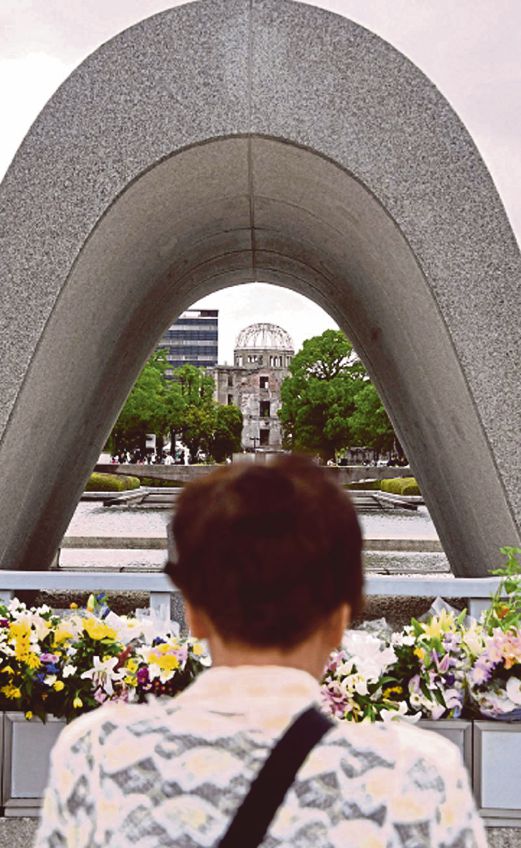Lessons from Hiroshima for Gaza
Professor Tan Sri Dato' Dzulkifli Abdul Razak
Learning Curve: Perspective
The New Straits Times - 6-8-2014
TODAY, we recall what happened on Aug 6 at 8.15am some 69 years ago. It is the grim anniversary of the only atomic bomb that exploded on a living city, namely Hiroshima. As though that is not enough, Nagasaki was targeted three days later.
At this time, I reminisce over what my late father, Abdul Razak Abdul Hamid, a Hiroshima bomb survivor who passed away in July last year, would religiously repeat over the years.
He was a student of 19 years of age when the bomb exploded barely 1.5km from his alma mater, the then Hiroshima University, known for its educational studies.
What seemed obvious was how he had to miraculously cope with the on-going war between Japan and the Allied Forces led by the United States. And, more gruesomely, how the Japanese people, the majority of whom were innocent civilians, suffered from the scourge of the aftermath of the nuclear attack unimaginable even to the designers, makers and deliverers of the bombs!
To Razak, his life seemed to revolve around the sound of the siren that could make a difference between life and death. Being in a war zone that is constantly under attack, the siren is an early warning of an impending air raid.
Each time the siren screamed, everyone hastened into the purpose-built bomb-shelters to seek refuge. It is only when the “second” siren was on that they emerged from the shelters assured that the dangers of air attack were over.
This cycle took place often enough that it became almost routine with no “eventful” consequence mostly. Life continues until another siren is sounded, and another disruption. Thanks largely to the bomb-shelters that were readily accessible, the common people were not duly targeted, unintentionally or otherwise.
In fact, they were trained on how to approach the shelters efficiently so that it was not chaotic, since time is of essence; and also how to emerge and disperse safely once out of the shelters. It became second nature to observe orderliness, discipline and patience so that movement was kept to the minimum and safety was not compromised.
Razak found such training particular importance since he was still adapting to the Japanese milieu, what was more being at war. Organising his schedules around the bombing alerts and the sirens, he began to focus on his studies.
In fact, on the tragic morning when the atomic bomb was released, he was attending a mathematics class. Despite the routine experiences, this time, the consequences were disastrous beyond imagination.
It is attributed not just to the technological superiority against the enemies but equally potent cultural superiority-cum-hatred that made the bombings and killings “honourable” acts to be accomplished by all means.

A woman praying for victims of the 1945 atomic bombing while
looking towards the Atomic Bomb Dome (background) at the
Peace Memorial Park in Hiroshima. The Japanese city marks the
69th anniversary of the world's first atomic attack today. AFP pic
The phrase “yellow peril” (implying East Asians known as the “yellow races”), for example, had been in common use in the US media, reportedly owned by one William Hearst since the 1930s. Still, earlier in 1911, The Yellow Peril or Orient vs. Occident was allegedly a popular book by Greenberry Rupert, an influential US pastor. Similar bigotry is not uncommon today, albeit more subtle and hypocritical.
Hence, unlike conventional bombs, the deadly atomic bomb was designed to cull as many enemies as possible. It was timed to explode after the “second” siren was sounded and the innocent people were beginning to emerge from the shelter, as always, assuming that the danger was over.
The explosion was also delayed to enable the Boeing B-29 Superfortress bomber to fly far enough so as not to be engulfed by the infamous “giant mushroom cloud”; so symbolic of the immense destruction that was associated with it!
That was how hundreds of thousands of innocent Japanese were pulverised in almost an instant. Razak aptly described what he saw as padang jarak, padang tekukor!
It shocked not only the victims but also the attackers. Allied Forces co-pilot Robert Lewis wrote in his log: “My God, what have we done?” And, Albert Einstein, in a Dec 10, 1945 speech, said: “The war is won, but peace is not.”
Einstein should know better since he alerted US president Franklin D. Roosevelt about the possibility of the “new” bomb. Indeed, what he said resonates with the ongoing war in Gaza, which flared up yet again. How many times the “wars” have been
won but “peace” continues to remain elusive!
What can be more elusive if basic life-saving facilities like early warning sirens and shelters are not available to the common people, let alone essentials (food, utilities and medical supplies) in a prolonged war of unequal proportions; no doubt blinded by the cultural superiority and centuries-long hatred that have led to many genocides and massacres until today.
The war-mongering will therefore continue unless, as advocated by the late Razak, there is an effort to teach and learn how to “hate” not just wars but all forms of aggression and violence, be it in thoughts, words and certainly deeds!
